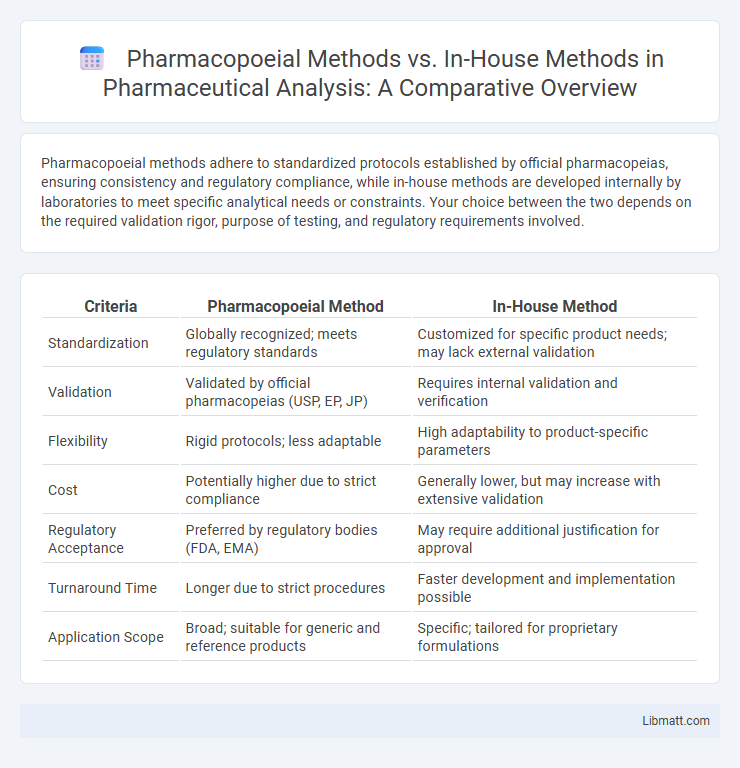Pharmacopoeial methods adhere to standardized protocols established by official pharmacopeias, ensuring consistency and regulatory compliance, while in-house methods are developed internally by laboratories to meet specific analytical needs or constraints. Your choice between the two depends on the required validation rigor, purpose of testing, and regulatory requirements involved.
Table of Comparison
| Criteria | Pharmacopoeial Method | In-House Method |
|---|---|---|
| Standardization | Globally recognized; meets regulatory standards | Customized for specific product needs; may lack external validation |
| Validation | Validated by official pharmacopeias (USP, EP, JP) | Requires internal validation and verification |
| Flexibility | Rigid protocols; less adaptable | High adaptability to product-specific parameters |
| Cost | Potentially higher due to strict compliance | Generally lower, but may increase with extensive validation |
| Regulatory Acceptance | Preferred by regulatory bodies (FDA, EMA) | May require additional justification for approval |
| Turnaround Time | Longer due to strict procedures | Faster development and implementation possible |
| Application Scope | Broad; suitable for generic and reference products | Specific; tailored for proprietary formulations |
Introduction to Analytical Methods in Pharmaceuticals
Pharmacopoeial methods are standardized analytical procedures officially recognized and validated by regulatory authorities, ensuring consistency and reliability in pharmaceutical quality control. In-house methods, developed internally by laboratories, offer tailored solutions but require thorough validation to meet regulatory acceptance. Your choice between these methods affects the robustness, reproducibility, and compliance of pharmaceutical analysis.
Defining Pharmacopoeial Methods
Pharmacopoeial methods are standardized analytical procedures officially published in pharmacopoeias to ensure the quality, purity, and potency of pharmaceutical substances and products globally. These methods undergo rigorous validation, are universally recognized, and serve as authoritative references for regulatory compliance. In contrast, in-house methods are internally developed protocols tailored to specific laboratory settings but may lack the widespread acceptance and regulatory endorsement granted to pharmacopoeial methods.
Understanding In-House Analytical Methods
In-house analytical methods are developed within a laboratory to meet specific testing requirements that may not be fully addressed by pharmacopoeial methods, offering flexibility and tailored solutions for your quality control processes. These methods require rigorous validation to ensure accuracy, precision, and reliability comparable to official pharmacopoeial standards such as USP, EP, or JP. Understanding the advantages and limitations of in-house methods helps optimize your analytical strategy while maintaining compliance with regulatory expectations.
Regulatory Requirements and Compliance
Pharmacopoeial methods are standardized and officially recognized for regulatory submissions, ensuring consistent compliance with global regulatory authorities such as the FDA and EMA. In-house methods require thorough validation to meet regulatory expectations, demonstrating equivalency or superiority to pharmacopoeial standards. Compliance hinges on documented method validation, system suitability tests, and ongoing performance verification to satisfy audit and inspection criteria.
Validation and Verification of Methods
Pharmacopoeial methods undergo rigorous validation by official regulatory bodies, ensuring standardized accuracy, precision, specificity, and robustness across laboratories worldwide. In contrast, in-house methods require thorough internal validation tailored to your specific laboratory conditions, with an emphasis on verifying method suitability and reproducibility for intended analytical applications. Effective verification processes confirm consistent performance according to predefined acceptance criteria, safeguarding the reliability of results whether employing pharmacopoeial or proprietary methodologies.
Accuracy and Reliability: A Comparative Analysis
Pharmacopoeial methods are standardized and validated by regulatory authorities, ensuring high accuracy and reliability in analytical results, while in-house methods may vary in precision depending on the laboratory's validation processes. You can expect pharmacopoeial methods to provide consistent reproducibility across different laboratories, whereas in-house methods require rigorous internal validation to achieve comparable reliability. Comparing both, pharmacopoeial methods offer a benchmark of trustworthiness essential for regulatory compliance, whereas in-house methods offer flexibility but demand strict quality control measures.
Flexibility and Adaptability of Analytical Processes
Pharmacopoeial methods offer standardized analytical procedures with limited flexibility due to strict regulatory requirements, ensuring consistency across laboratories. In contrast, in-house methods provide greater adaptability, allowing customization to fit your specific sample matrix and workflow needs, enhancing efficiency and responsiveness to unique analytical challenges. This adaptability facilitates rapid method modifications and optimization, essential for dynamic research and development environments.
Cost Implications and Resource Allocation
Pharmacopoeial methods typically incur higher costs due to stringent compliance requirements, specialized reagents, and standardized equipment, impacting budget allocation significantly. In-house methods offer flexibility and reduced expenses by utilizing existing resources and staff expertise, allowing for tailored workflows but may lack regulatory standardization. Resource allocation for pharmacopoeial methods demands dedicated training and quality control personnel, while in-house methods require investment in development and validation to ensure accuracy and reliability.
Case Studies and Practical Applications
Pharmacopoeial methods offer standardized protocols validated across multiple laboratories, ensuring regulatory compliance and reproducibility in pharmaceutical analysis. In-house methods provide tailored solutions optimized for specific formulations or equipment, often improving efficiency and cost-effectiveness in routine quality control. Case studies reveal that integrating pharmacopoeial methods with in-house adaptations enhances method robustness, addressing unique product challenges while maintaining adherence to industry standards.
Choosing the Optimal Method for Quality Control
Selecting the optimal method for quality control involves comparing the Pharmacopoeial method, which offers standardized, regulatory-accepted procedures ensuring global consistency, against the in-house method tailored to specific production needs for enhanced flexibility and cost efficiency. Pharmacopoeial methods provide validated, reproducible results critical for compliance with regulatory agencies such as the FDA and EMA, while in-house methods allow customization to unique formulations or operational constraints, potentially improving detection sensitivity. Evaluating factors like accuracy, precision, validation status, and regulatory acceptance aids in determining the best fit for maintaining product quality and meeting industry standards.
Pharmacopoeial method vs in-house method Infographic

 libmatt.com
libmatt.com